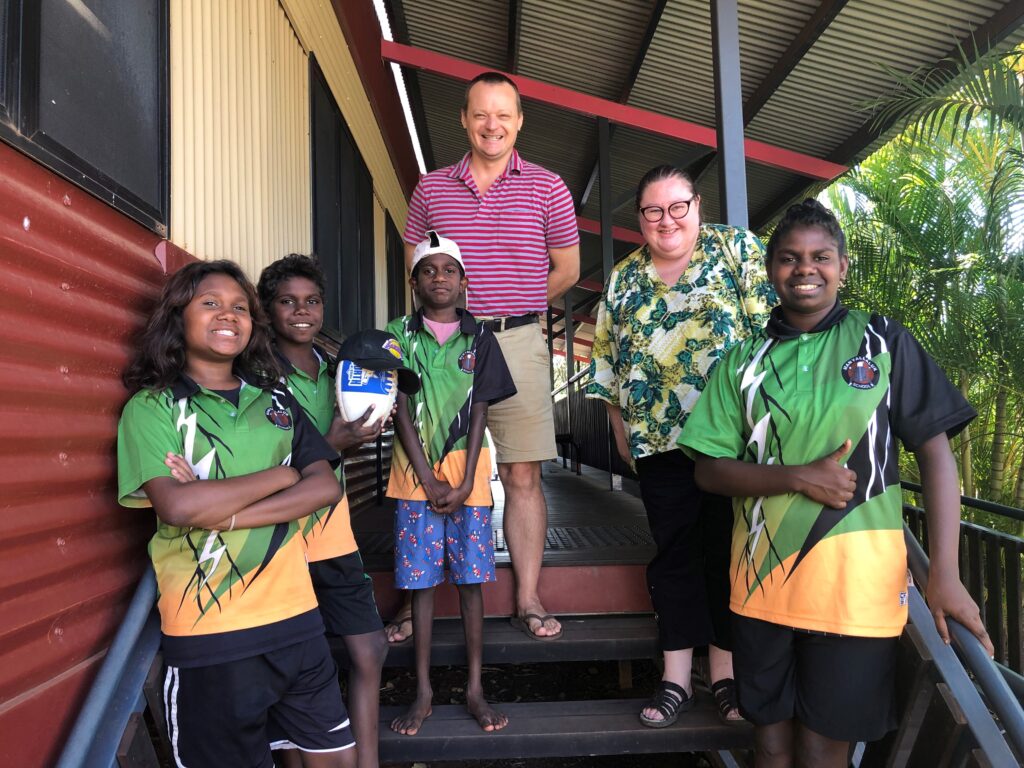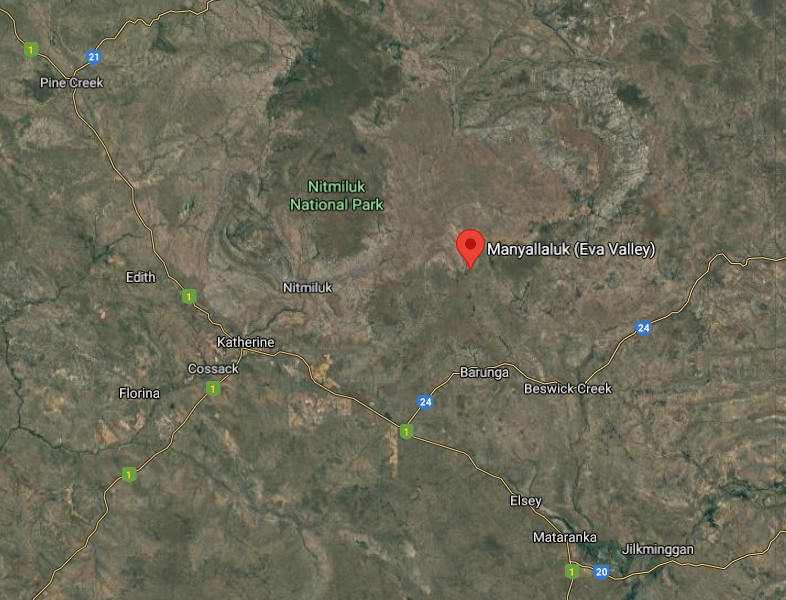Principal Ben (centre) with students and former AEU NT Organiser Alyson Kavanagh
Principal Ben Kleinig writes with pride about a little school in the Katherine region doing big things
Two or three days’ walk upstream of Katherine Gorge, you can find a little creek called Emu Creek (or Tourist River), and if you follow that for another day or two you can find Manyallaluk sitting on some of the Top End’s higher ground.
Or you could just drive about 100km from Katherine in an hour-and-a-half. The country right here at Manyallaluk drops away into the Katherine River, but on the escarpment behind the community the country drops away into the Waterhouse, Roper and King Rivers. We don’t really get properly cut-off here, but our rain can cause cut-offs at other places.
There’s a nice little primary school at Manyallaluk, in a building maybe 12 or 15 years old (school was held in the old shop building before that). It’s a small community, usually fewer than 90 people, and at any given time there are about twenty-something kids on the roll.
We disagree with the official attendance data because it doesn’t adequately tell the whole story. We like to say that we have almost 100% attendance of those kids who are in-community and healthy. Kids sometimes humbug the teachers to do school on weekends, but we are only human and need to rest!
There’s something pretty special about Manyallaluk. We don’t really have break-ins or vandalism and graffiti. Maybe it’s the small size of the community, or maybe it’s the Christian faith held by the community. Or maybe it’s the people’s constant connection to their surroundings, to simple, good things like campfires, fishing and hunting, to old stories, funny stories and caring for country.
That said, there is another side of the story, including the familiar challenge in the NT context of the impact of trauma.
That said, there is another side of the story, including the familiar challenge in the NT context of the impact of trauma. When we got here, we thought we knew a little bit about remote teaching and bush kids, yet we experienced some really tough times because we were trying to do things the old-fashioned way (dishing-out punishments for inappropriate behaviours) and the kids won that little competition every time!
There had to be a better way, and our junior primary teacher found a course about trauma-informed teaching and completed it, and led the whole school to adopt a better way through understanding the brain, having real conversations, being restorative and knowing when space and time is required. We’re still on that journey five years later, but it’s a rich and rewarding journey.
Something else that has helped our school immensely is helping connect kids and families with paediatricians. Years ago a long-time teacher told us not to bother trying to get Aboriginal kids any medical help. It was an attitude that I found appalling, but I think this person probably meant that it was actually almost impossible to get any help no matter how much you ask for it.
We found it was almost impossible, and then a kind nurse helped connect us to a paediatrician, and since then we’ve strengthened that relationship with the paediatricians who service our area and we’ve been able to help each other to get kids the healthcare they need, and it’s made a massive difference to safety and learning at school.
All the good stuff I’ve already mentioned about trauma, healthcare, STEM and two-way learning is all about helping kids learn. It all links.
Last year in November, our little school travelled to Darwin to present our STEM project to various scientists and land-care groups at the Northern Territory Natural Resource Management conference. It was an amazing event to be a part of, and the youngest presenter was one of our kids – just five years old.
We won a really magnificent trophy for our project, which was monitoring the nearby creek for buffalo numbers throughout the year using our school’s drone. This included making hypotheses and graphing the results, then analysing it all. This has been a springboard into other wildlife monitoring projects that are ongoing, especially using spy cameras to search for Gouldian finches and echidnas, and using a GoPro camera to see what lives in the creeks. You can check this out on our Manyallaluk School YouTube channel.
Although not an official program, we have something that could be called Two-Way Learning, and it’s where we are all students and teachers, no matter what our age is. This really comes alive with Kriol and Culture. The kids and families teach us their language, stories and skills, and they show us their Country. The richness of this culture and traditional knowledge is something that we consider an immense privilege to learn from. We teachers become the students and it makes a strong bond. At any given moment at school, things are happening in Kriol or English or both. It’s fun!
Something we were really blessed to inherit from previous teachers and principals here is the growth mindset that kids have. They’re not afraid to try with reading, writing and mathematics. They give it a red-hot go, and we’ve been so fortunate to build upon the brilliant work of those who served here before us.
All the good stuff I’ve already mentioned about trauma, healthcare, STEM and two-way learning is all about helping kids learn. It all links.
We have a couple of mantras: “Are we here to party? No! We’re here for hard work and learning!” and “We love mistakes! Why? Because it means we’re trying and we learn from them.”
This is an extended version of an article published in the Semester 1, 2021 edition of the Territory Educator.


